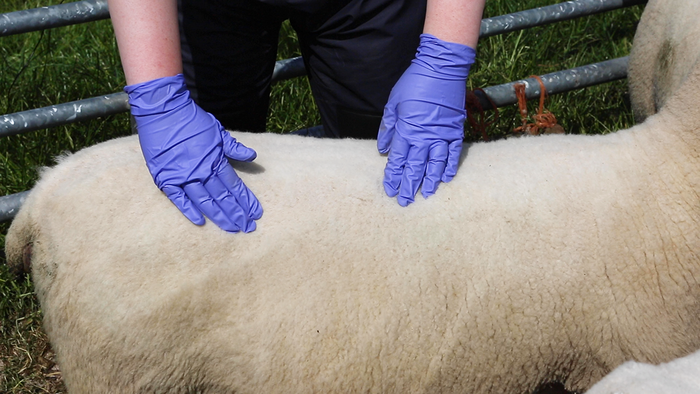As tupping time approaches, sheep farmers can optimise their flock performance using body condition scoring (BCS), says Emily Hall, technical specialist for Net-Tex.
“Body condition scoring is an easy to implement and valuable tool to evaluate what body reserves an animal has at a point in time. It allows management decisions for future nutritional allocation to be made to help support individual ewe and overall flock performance,” says Ms Hall. “It is essential that ewes are in the target body condition score for the stage in the production cycle to maximise conception rates and embryo survival during the tupping period, whilst reducing the risk of metabolic disease and other lambing problems occurring around lambing time.”
How to BCS ewes
When conducting BCS assessments, it must be done by hand and preferably by the same person, using the same hand each time.
“Wool growth at different times of the year can be quite deceiving of fat and muscle cover so therefore we must get hands-on to get an accurate insight into the nutritional status of the flock,” she explains. “We also need to make sure the same person is hands-on and the same hand is used each time so that scores remain consistent. For example, what one person may call a BCS of 3, another may call it a 2.5. And to truly optimise management decisions, sheep need to be scored as consistently as possible.”
To assess body condition through the wool, the person doing the scoring should focus on the spinous and transverse processes. The spinous processes is the part of the spine that points upwards, running down the sheep’s back. The transverse processes is the bony protrusions on either side of each vertebrae.
“Gently run your hands over the spine and loin area, applying pressure to feel how prominent the bones are and the fat and muscle covering of the bone. If it is easy to feel the bones of the spine and the transverse processes, then the ewe is on the lower end of the BCS scale. If it requires a little pressure on the back to feel the bones, she is going to be towards the middle of the scale,” says Ms Hall. “It is very unlikely a ewe in a commercial flock, who has reared lambs, will be a BCS of 5 at weaning time. If she has been working hard and producing lambs with good growth rates, she will most likely need to gain body condition following the weaning period.”
Understanding the BCS scale
Industry-standard for BCS is to use a five-point scale with the option to use half scores such as 2.5. The rule of thumb is to treat one condition score to the equivalent of 10-13% of body weight. So, for a 70kg ewe, one condition score is 7 to 9kgs and a half score is 3.5 to 4.5kgs.
BCS 1 – Lack of fat cover makes the spine and vertebrae prominent and sharp. It’s easy to push fingers below the transverse processes, which can be felt individually.
BCS 2 – Vertical and transverse processes are still prominent, but smooth. Individual processes can be felt but in joined sections. Moderate pressure is needed to press fingers below the transverse processes. The loin has little fat cover.
BCS 3 – The spine and vertebrae are detectable with little pressure but feel smooth and rounded. The loin is full with moderate fat cover.
BCS 4 – Hard pressure is required to feel the vertical and transverse processes and individual vertebrae are hard to detect. The loin muscle has a thick fat cover of fat and is full and rounded.
BCS 5 – When applying hard pressure, it is impossible to detect the vertical and transverse processes and instead, there is a dimple of fat where they should be. The loin muscles are covered with a very thick layer of fat.
Using BCS for management decisions
Once body condition has been assessed, ewes can be split into management groups so feeding regimes can be controlled more accurately.
“This will allow ewes who are under condition to gain BCS or ewes in the correct BCS to maintain condition. Overfat ewes should be managed carefully as it is not advised to target BCS loss during key periods such as tupping and pre-lambing,” says Ms Hall.
In the period from weaning to tupping, ewes typically need to gain 1 BCS, or 10 to 13% of their body weight to be in the target range. By tupping, 90% of the flock should be at a BCS of 3.5 for lowland ewes or 2.5 for hill ewes.
“For ewes needing to gain 1 BCS from weaning to breeding, they will need unrestricted access to high-quality grazing for six to eight weeks,” concludes Ms Hall. “If this is not readily available or more condition needs to be gained back, supplementing ewes with a high protein and energy feed block or bucket will help to meet those nutritional requirements.”



